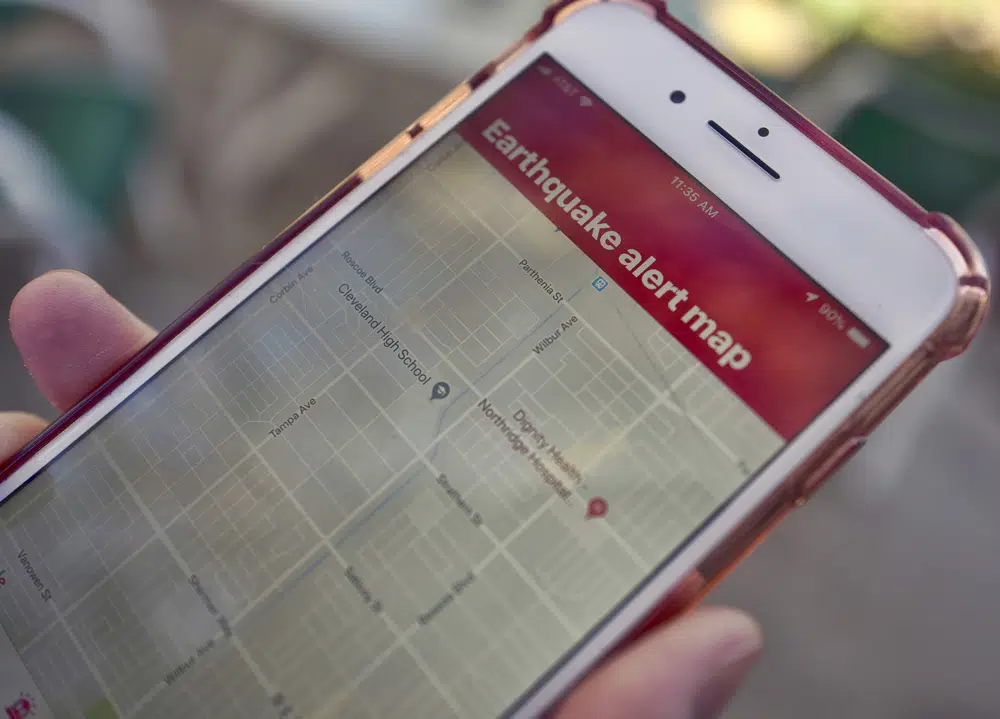California earthquake puts early warning system to the test

Sacramento, The Gulf Observer: As sensors picked up the first signs of a strong earthquake jolting the Northern California coast, an alert was blasted to 3 million smartphone users telling them to “drop, cover, hold on.” It was hailed as the biggest test yet of the warning system since its public launch.
But the people most rattled by the magnitude 6.4 earthquake early Tuesday said the alert didn’t give them enough time to take cover as the temblor shook homes off foundations, knocked out power and water to thousands, and injured more than a dozen people.
Jimmy Eller, who was sitting in his parked Chevy Malibu while working as a security guard, said he was already in the throes of the violent quake when he noticed his phone had lit up with the warning. He was more focused on what was going on outside as street lamps began to sway.
“They were all wobbling, flashing on and off,” Eller said. “I could see breakers and wires in the distance flashing like lightning might look like. It was terrifying. You could see everything moving and shaking.”
The quake was centered near the small town of Ferndale, about 210 miles (345 kilometers) northwest of San Francisco. It was the biggest one the ShakeAlert early warning system has alerted for, since launching publicly in California three years ago.
“It’s really a groundbreaking, first-in-the-nation tool that hopefully saves lives,” said Brian Ferguson, a spokesperson for the California Governor’s Office of Emergency Services.
ShakeAlert was developed by university researchers and is operated by the U.S. Geological Survey. It’s one of a handful of earthquake warning systems created in different parts of the world over the past few decades, including Japan and Mexico. But the new technology, which operates in California, Oregon and Washington, is not without its challenges.
Before alerts get sent to people’s phones, multiple seismometers have to detect movement below Earth’s surface. That information can then be processed to determine the earthquake’s location and magnitude. That process, from seismometer detection to an alert being sent, is all automated, said Robert de Groot, a scientist with the ShakeAlert operations team.
Jen Olson, who lives in Arcata about 25 miles (40 kilometers) from the epicenter, said she was awoken by shaking and her phone going off at the same time. She’s not sure which woke her up first, but she said the loud noise and bright light from her phone probably helped her realize the severity of the quake.
Worried about her dog, who was asleep in a crate, she quickly got up and headed for the back door, to either stand in for shelter or to head outside if the house began to collapse.
“It might have taken longer for the shaking to wake me up if the phone hadn’t also been making a lot of noise,” she said.
Jay Parrish, the city manager of Ferndale, said he wasn’t aware of anyone getting the alert. Unlike a tsunami or flooding in which there is plenty of time to prepare for a potential disaster, he didn’t think an earthquake warning system could provide enough advance notice.
When told that the alarm sounded for some 10 seconds before the violent shaking, he said: “That might have saved one of my glass jars.”
It’s hard to pinpoint the reason why someone who should have received the alert did not without having more information, de Groot said. Some people may have turned off the notifications from Wireless Emergency Alerts, the same system run by the federal government that sends Amber Alerts to phones.
A glitch in an earthquake warning app for San Diego residents that relies on the system’s data falsely alerted people more than 650 miles (1,040 kilometers) away from the epicenter.
This was the first time the system alerted people in two states — both California and Oregon, de Groot said. There’s a study underway to explore alerting in parts of Alaska in the future.
Various apps use ShakeAlert’s data to notify people who could experience significant quake effects. People were alerted within a radius of about 250 miles (400 kilometers) from the epicenter of Tuesday’s Northern California quake, said Richard Allen, director of the Seismology Lab at the University of California, Berkeley.
In a 2021 blog post, the Seismology Lab explained why we don’t know when an earthquake will happen before it starts.
“The physical processes along an earthquake fault before and during a rupture are so complex that seismologists have all but given up on trying to achieve the elusive goal of predicting when a strong quake will happen,” it read.
The lab developed an app called MyShake that notified about 270,000 residents about the temblor.
“From a technical standpoint, I would say the system did a great job,” Allen said.
Allen said the next step is helping people understand the importance of dropping to the ground so that they do it automatically, which could help prevent injuries.
About 140 miles (225 kilometers) from the earthquake’s center, Anna Hogan, a student at California State University, Chico, was talking on the phone with her brother when an alert came through. She took cover. And while she didn’t end up feeling the earthquake, she’s glad she moved to a safer spot.
As someone who’s lived in earthquake-prone areas like Alaska and San Francisco, she knows the toll they can take.
“It scared me, yes,” she said of the alert. “But being able to shelter in place is better than not.”


